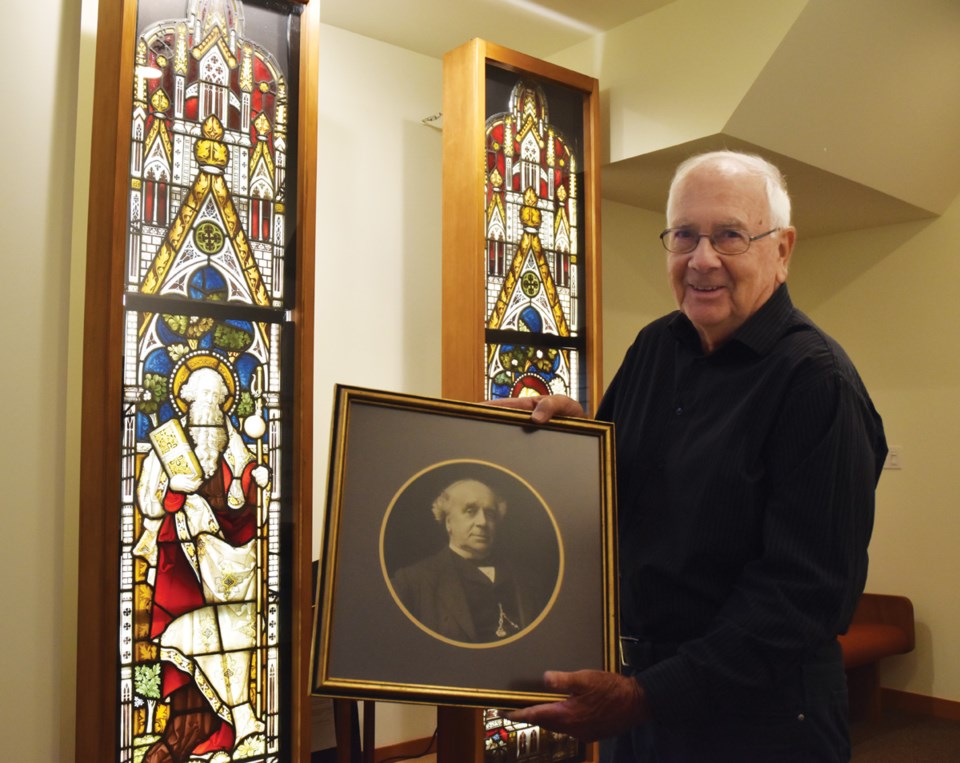Before the Clayton family developed properties and sold groceries in Sechelt, the family name was famous for another more artistic line of business – stained glass. Pieces can be found at Westminster Abbey, Cambridge University, the Albert Memorial in Hyde Park, and in Australia, Canada, New Zealand and the U.S.
Beginning in 1855, the stained glass firm Clayton and Bell produced pieces renowned for their rich colours and luminosity and were one of the most successful firms of their era.
For the first time, their work can also be found in Sechelt. The effort to bring the Clayton glass home has been months in the making.
It started when Dick Clay-ton, CEO of Trail Bay Group of Companies, explained the family connection to son-in-law Paul Meyer.
“Dick shared a story with me of what his great-grandfather did and showed me his photo. I shared that with a dear friend of mine,” Meyer said. Eventually, after some digging, two pieces emerged about seven months ago through stained glass art dealers based in Bedfordshire, north of London.
The two pieces were purchased for approximately £10,000 (C$16,886) and shipped to Sechelt, where they are being temporarily displayed at St. Hilda’s Anglican Church.
“It’s nice to see them – certainly it’s nice that they are part of the family history – but we’re not sure where they’ll go yet,” said Clayton, whose great-grandfather was John Richard Clayton, co-founder of the firm.
While the family no longer deals in glass, the success and history of the business remains a part of the Clayton collective memory. Bruce Morris, a Clayton family member, recalls travelling around England when he was living there in the 1980s, searching out Clayton and Bell windows.
“One of the things they were noted for was the colours that they were able to achieve in the glass itself,” said Morris while peering at the two pieces before him at St. Hilda’s. “They went back to medieval glass-making techniques to get these vibrant blues and reds and greens that you can see in these windows.”
Those colours are on full display at St. Hilda’s. One panel features St. James holding a pilgrim’s staff and a water gourd. The other features St. John, the writer of the fourth of the gospels, featuring an eagle. The gospel of John explores in great detail theological interpretations of the life of Jesus Christ. “It was like the eagle soaring up into new realms of understanding. So the eagle is often reflective of St. John,” said Morris. The two windows were crafted in 1885 but their origins are unknown.
Modern stained glass is typically smaller pieces of stained glass soldered together, but these panels are large pieces of smooth glass stained one colour and then painted. “These are literally painted stained glass windows. That’s how you get all the detail,” Morris said.
The pieces will remain at St. Hilda’s until early March, during which time the Clayton family will decide where they will be displayed next. “We don’t know yet whether we will display them in the mall, whether we will install them in another building if we build another building, what we will do. We don’t know yet,” Dick Clayton said.
John Richard Clayton, the co-founder of Clayton and Bell, was a gifted designer and trained sculptor who also studied architecture and ecclesiastics. Eventually, he transitioned to designing stained glass after falling in love with the medieval art form while working at Wells Cathedral in Somerset.
Clayton was a friend of several struggling artists as well as literary giant Charles Dickens. He frequently contributed anonymously to the Times and other newspapers. He died in 1913 but the business and name continued through the work of his son, John Essex Clayton. According to Dick Clayton, John Essex Clayton was a painter at heart. “My grandfather left the firm, he wanted just to paint, he didn’t want the commercial part of it. He was just an artist.” The firm dropped the Clayton named and carried on producing stained glass for domestic and international clients until it folded in 1993.
John Essex Clayton’s son, Edric Clayton, is the original Sechelt Clayton. He arrived in 1919.



